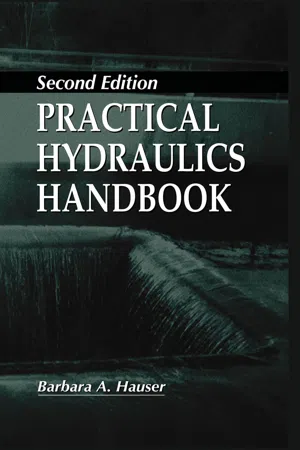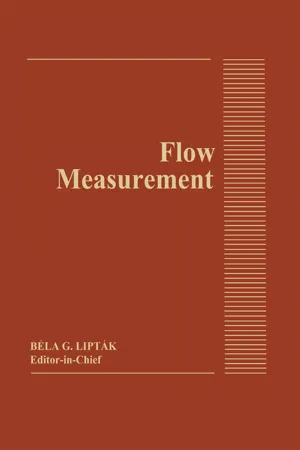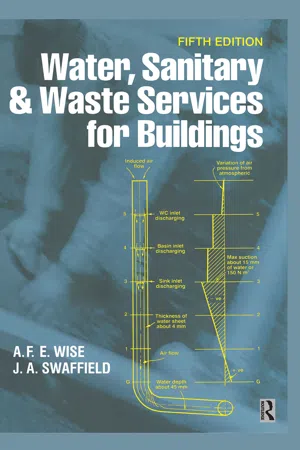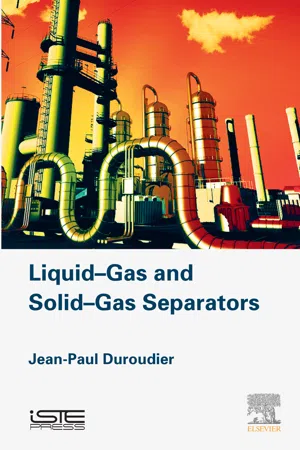Technology & Engineering
Venturi Effect
The Venturi effect is a fluid dynamics principle that describes the reduction in pressure when a fluid flows through a constricted section of a pipe. This phenomenon occurs due to the increase in fluid velocity in the constricted area, resulting in a decrease in pressure. The Venturi effect is utilized in various engineering applications, such as in carburetors and air flow measurement devices.
Written by Perlego with AI-assistance
Related key terms
Related key terms
1 of 4
Related key terms
1 of 3
4 Key excerpts on "Venturi Effect"
- eBook - ePub
- Barbara Hauser(Author)
- 2017(Publication Date)
- CRC Press(Publisher)
Take another example, that of a pipe whose diameter differs from point to point. Point 1 lies in the pipe with the narrower diameter, Point 2 in the wider pipe. Referring back to the Equation of Continuity (Q = AV), in a steady state system, if the cross sectional area increases, the velocity of the water will decrease. Therefore, the Velocity Head at this point will also decrease. Bernoulli’s formula states that the total energy must remain constant from point to point. That means that one of the other forms of energy must increase at Point 2. Since this is a horizontal pipe, it is the Elevation Head. It is the Pressure Head that increases, and by the amount that the Velocity Head decreased from Point 1. When velocity decreases, pressure energy increases.The opposite would happen if the pipe had decreased in diameter. Velocity increases, and pressure decreases. Utility personnel take advantage of this phenomenon when using the Venturi Meter, another flow measuring device. The structure of a Venturi is similar to a pipe which has been squeezed in the middle, creating a narrow diameter at the constricted section. A pressure gage is inserted at this point, and another one just upstream from the constriction. The gage at the constricted throat will read a slightly lower pressure than the one upstream, and the difference, when the readings are converted to feet, will be the difference in the Velocity Heads between the two sections. At normal water pipe flows, Velocity Head at the wider section often is assumed negligible, and so the pressure differential can be equated to the Velocity Head at the constriction. This is easily convertible to a value for velocity (Vh = V2 /2g); then using the throat diameter and Q = AV, a flow value can be obtained.Note: When pressure changes because velocity changed, the difference between the two pressures is the Velocity Head.It should be emphasized that these internal energy changes within a pipe system, are results of structural configuration, and can be reversed, by reverting back to the original structure. In this diagram, as in the Venturi Meter, the pipe constricts, and the pressure drops. The constricted section then enlarges to the original diameter, and the pressure at Point 1 is returned at Point 3.Bernoulli’s Formula has stated the theoretical equivalence of energies from point to point in a steady state flow system. However, in this form it does not account for the friction losses which occur in an actual dynamic system. - eBook - ePub
- Bela G. Liptak(Author)
- 2020(Publication Date)
- CRC Press(Publisher)
Head metering is one of the most ancient of flow detection techniques. There is evidence that the Egyptians used weirs for measurement of irrigation water in the days of the Pharaohs, and that the Romans used orifices to meter water to households in Caesar’s time. In the 18th century, Bernoulli established basic relationships between pressure head and velocity head, and Venturi published on the flowtube bearing his name. However, it was not until 1887 that Clemens Herschel developed the commercial venturi tube. Work on the conventional orifice plate for gas flow measurement was commenced by Weymouth in the United States in 1903. Recent developments include improved primary elements, refinement of data, more accurate and versatile test and calibrating equipment, better differential pressure sensors, and many others.Theory of Head Meters
Head-type flow measurement derives from Bernoulli’s Theorem which states that in a flowing stream, the sum of the pressure head, the velocity head, and the elevation head at one point is equal to their sum at another point in the direction of flow plus the loss due to friction between the two points. Velocity head is defined as the vertical distance through which a liquid would fall to attain a given velocity. Pressure head is the vertical distance which a column of the flowing liquid would rise in an open-ended tube as a result of the static pressure.This principle is applied to flow measurement by altering the velocity of the flowing stream in a predetermined manner, usually by a change in the cross-sectional area of the stream. Typically, the velocity at the throat of an orifice is increased relative to the velocity in the pipe. There is a corresponding increase in velocity head. Neglecting friction and change of elevation head, there is an equal decrease in pressure head (Figure 14a - eBook - ePub
- A.F.E. Wise, John Swaffield(Authors)
- 2012(Publication Date)
- Routledge(Publisher)
These relationships form the basis for considering flows of the kind normally encountered in building services. They relate to imcompressible fluids and thus may be used for water flowing in pipes or in open channels and also for ventilating air, since air may be regarded as incompressible for the conditions normally encountered in ventilation practice.Pipe friction
Bernoulli's equation relates to an ideal fluid. Experiment shows, however, that the ‘total’ head at points along a straight pipe is not constant, as Bernoulli predicts, but reduces in the direction of flow.Considering two stations along the horizontal pipe in figure 8.1 :H1 > H2Bernoulli's equation is modified to:H1 — H2 + hfwhere hf is the ‘loss’ of head in the pipe run due to fluid friction. When a bend is added to the length of pipe a further loss of head is encountered owing to the turbulent disturbances caused by the bend. Features such as changes of section and fittings and valves also cause additional losses, which are variously known as fitting, secondary, minor or dynamic losses and are of importance in many building services installations. The total pressure drop in a circuit (total resistance) is obtained by summing the individual losses of fittings and those due to piping or ductwork.Resistance to the flow of a fluid along a pipe is caused by viscosity. Viscosity is due to cohesion and interaction between fluid molecules and causes friction forces to be set up between layers of fluid travelling at different velocities. Experimental observations show that when a fluid flows along a pipe the velocity increases from zero at the pipe wall to a maximum at the pipe axis. Reynolds in the 1880s demonstrated two types of flow in glass tubes. At low velocities a jet of dye introduced into the flow remains in a thin thread indicating that particles of fluid are moving in straight, parallel paths. This type of flow is known as laminar flow. At higher flows the thread breaks up and mingles with the fluid; the flow is then said to be turbulent. - eBook - ePub
- Jean-Paul Duroudier(Author)
- 2016(Publication Date)
- ISTE Press - Elsevier(Publisher)
In the divergent, compression is at work, and the vapor condenses onto the dust if that dust is at least partially soluble in the liquid. Thus, the dust particles serve as nuclei for the condensation of the vapor. In the liquor obtained by partial dissolution of the solid, the activity of the water is less than 1, and therefore the condensation takes place preferentially on the dust. Thus the dust particles become heavier and larger, making them easier to capture.The device is all the more effective when the relative velocity of the gas with respect to the drops is high, which explains why venturis generally see the entrainment of the liquid by the gas, rather than the other way around. Indeed, the velocity of the gas at the neck is between 100 and 500 m.s- 1 , whereas a liquid can only be injected at a velocity of the order of 10–25 m.s- 1 .The effectiveness of the venturi remains constant and independent of the gaseous flowrate if the gas encounters the liquid at a velocity independent of that flowrate. To make this possible, the inlet section has two lateral shutters whose inclination can be regulated to maintain a constant value for the pressure drop on passing through the device. Indeed, the depression at the neck is poorly recovered in the divergent section.Figure 3.1 Principle behind the venturi3.1.2 Usage of a venturi
The venturi is effective in stopping fine dust particles (< 1 μm), provided the velocity of the gas in the device is sufficient, meaning that the corresponding pressure drop is sufficiently great. This device is used to scrub combustion fumes and gases from certain ore-treatment plants (phosphate ore, for example) or fertilizer factories.3.1.3 Energy equation
For the suspension of drops of liquid in the gas, we merely need to write that the sum of the enthalpies and kinetic energies of the gas and the liquid is a constant:W GH GT +W Lh LT +W GE+C GW LE= const .C LWG and WL : mass flowrates of the gas and liquid (kg.s- 1 )HG and hL : gravimetric enthalpies of the gas and the liquid (J.kg- 1
Index pages curate the most relevant extracts from our library of academic textbooks. They’ve been created using an in-house natural language model (NLM), each adding context and meaning to key research topics.
Explore more topic indexes
Explore more topic indexes
1 of 6
Explore more topic indexes
1 of 4



